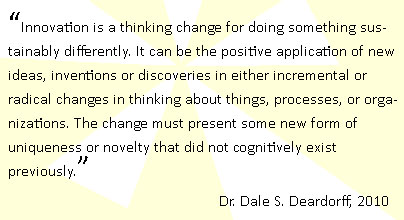


Novate
![]()

Recognize is the 1st step in the novate Innovation Process and is where you initially identify a perceived deficiency or problem in a system. This recognition of deficiency creates a clear understanding that there is a need for a new idea, approach or element. An initial Focus or Problem Statement is created and then dissected with the Ladder of Abstraction to clearly identify the system requirement and sensitivities. This focus on characteristics of a new or existing product or service can be quantified in initially cost (high to low), time (days to implement to weeks), complexity (simple to complex) and technology (known science to advanced concepts) parameters for ranking and rating at a later time. Functional mapping may be included to identify deficiencies in resources time & space domains. Operational definitions may be required to create a collective understanding for all participants.
Discover is the 2nd step in the novate Innovation Process and is where you instinctively and openly explore the previous design ideas or solutions to your problem. You review the solution space for alternate POV’s (Point-of-Views). This allows you to look at time and space domains that the deficiency exists in and reformulate multiple problems if necessary. It means you look at things with a different perspective, angle or change your preliminary assumptions and beliefs about the system structure that the problem resides in. Identification of system contradictions allows you additional stimulus and inspiration. This new solution space reflects an understanding of your personal paradigms, mental models and mindsets.
Pattern is the 3rd step in the novate Innovation Process and is where you recognize and match similarities, commonalities or dis-similarities creating new solution structures or behaviors. You are taking abstract parameters and putting them into categories that match or cognitively align to create good or bad system features or values. Patterns can exist in a linear or a non-linear form creating ideas, cycles or solution forms and boundaries. They can be rearranged, turned upside down and viewed backward. Extraction, scaling or segmentation are all aspects of patterning modes of thinking. To create a pattern may require you to break things apart and reassemble those differently creating sub-patterns. A pattern can exist in shape, size, color, function or behavior.
Novate is the 4th step in the Innovation Process and is where you replace something with something new by positive deconstruction and reconstruction through a lateral thinking mindset where the use of unorthodox or illogical methods are explored by creating a new pattern of thought for idea creation. This collaborative mindset explores non-obvious solutions by changing perceptions based upon positive serendipity. Structured brainstorming is balanced against random visual stimulus and random word triggers which create novelty in new ideas. The ultimate output is a new idea, method or device which can be seen to solve the solution space needs or wants. No filtering or prevention of idea formulation is used and the wild, crazy and “eureka” solutions are captured as well as the concrete, logical, methodical and traditional solutions.
Evaluate is the 5th step in the novate Innovation Process and is where the ideas solutions can be combine to create integrated design solutions. You can use a “Harvesting” technique to qualitatively refine, clarify, categorize and expand ideas and solution space. Additionally you use SCOR∑ tool to analytically quantify, rank, rate and evaluate ideas against the system requirements and sensitivities identified in the “Recognize” step. Any constraints which can prevent the successful implementation of the ideas will be captured and documented for future idea generating sessions. Additionally the strength or weakness of an idea can be determined and characterized into quantified themes. Ideas will be broken down into the beginning of ideas, concepts and ideas that can be immediately implemented. This shaping of the idea will improve the quantity and quality of the idea yield.
Implement is the 6th step in the novate Innovation Process and is where you actually create the proposed system that the idea was generated for. This can be a prototype, Beta or Preliminary version of the ideas, but would contain all of the functionality and characteristics of the new idea system. It is where we can research, build and test a working example(s) of ideas generated. Additionally you will determine the resources required to plan, execute and gather feedback on the practical performance of the idea solutions. The final output is reviewed for system ideality where the new ideas used to replace the old elements of the deficiency system in Step 1 would have a sum of more useful effects divided by harmful effects. You cannot exit the Implement process unless the new systems meets all system ideality requirements.
Linked Connections are the interconnected flow paths that illustrate the dynamic complexity of the novate Innovation Process system. These causal loop flowscape links visually show how the 6 steps are interlinked together and sequentially how the flow pattern moves forward and possibly backward to repeat. This also shows a topographical view diagramming of the flexibility of innovation thinking network. As the user moves through the Novate process they encounter changing problem conditions which may require mental reasoning reflected by the need to reverse a train of thought. The linked connections create the roadmap necessary to adapt to an abstract thinking process.
For more information on cost and event booking, email RPLC
